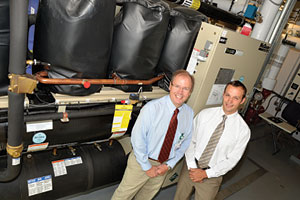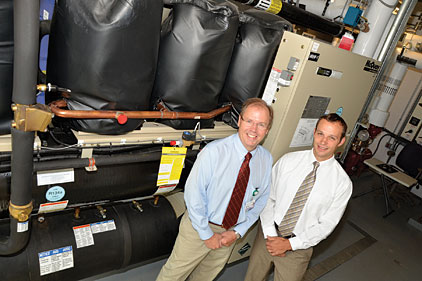
|
| Richard Morley, Central Vermont Medical Center vice president of support services (left) and Tim Perrin, key account manager, Efficiency Vermont, inspect a heat recovery heat pump system from McQuay called Templifier. The product recovers waste heat from the hospital’s chiller system and uses it to provide hot water during the summer months. |
Central Vermont Medical Center (CVMC) is making significant progress to reducing its energy consumption. Across the hospital, energy consumption has been reduced without sacrificing patient or employee comfort, thanks to the installation of a unique heat recovery system and ongoing improvements to the building automation control system.
Overall, the success at CVMC is due to the commitment of hospital executives, department staff, and partners Liebert Engineering Inc., Efficiency Vermont, and Control Technologies. Liebert Engineering is a Vermont-based firm that audited the hospital and designed its new system. Efficiency Vermont is a ratepayer-funded energy efficiency utility that provides technical assistance, rebates, and other financial incentives to help Vermont businesses and homes reduce their energy costs with energy-efficient equipment, lighting, and approaches to construction and major renovation. Control Technologies is a systems integrator located in Williston, Vt., that provides a digital web-based building automation controls system.
Together, these three partners were part of an energy savings initiative at CVMC that was able to cut annual electricity use by 717,000 kWh and cut fuel oil consumption by 10,400 gallons each year. Thus far, this initiative has led to a 4.8 percent reduction in annual energy consumption for hospital operations, slashing carbon emissions by 490 tons of CO2 annually with an expected lifetime reduction of 4,470 tons of CO2.
Audit Results
Liebert Engineering Inc. was initially hired to do a Level 3 ASHRAE energy audit for CVMC. Upon completion of the audit, the firm developed a number of high-impact, short-ROI energy reduction measures and included preliminary designs. When doing the audit, the firm found the oil consumption of the hospital in the summer months was just slightly less than in the winter. Further investigation revealed the oil consumption in the summer was due to the use of steam that was being used for reheat of the many air conditioning zones in the building.
Therefore, the biggest energy reduction measure was the installation of a heat recovery heat pump system from McQuay called Templifier. The product recovers waste heat from the hospital’s chiller system and uses it to provide hot water during the summer months.
“The Templifier is a product that extracts waste heat from chiller condenser water at about 90˚F and boosts to usable temperatures in the 140˚F range using a heat pump system,” explained Gregory Liebert of Liebert Engineering Inc. This technology is expected to significantly reduce CVMC’s fuel costs and carbon emissions.
Net Energy Savings
Richard Morley, CVMC vice president of support services, confirmed that the annual reduction of 73,000 gallons of No. 2 fuel oil translates to $238,000 in cost savings.
“Even when you factor in the expected increase in electrical consumption of 440,000 kWh, an additional $49,000 in electricity expenses, CVMC will see a net energy savings of $189,000,” he said.
Tim Perrin, key account manager for Efficiency Vermont, said, “In addition to the impressive savings that CVMC will see in their energy costs, the Templifier will provide an annual CO2 reduction of 1,050,000 pounds (525 tons) and a lifetime reduction of 7,900 tons. We are very pleased to be working with them to advance a project that is good for their bottom line, while furthering their efforts to be more sustainable.”
The Role of BAS
There are also other energy projects underway at the hospital being implemented through Control Technologies. The CVMC has a hybrid system that utilizes software from Invensys and Tridium and third-party integrations to manufacturers’ equipment like chillers and boilers.
Control Technologies incorporated a software analysis tool called SkySpark, which connects to the building automation system and database and uncovers hidden patterns within the data for energy management and building systems optimization. Once the system is optimized, it acts as a “watchdog” of the system and acts as a monitoring based-commissioning system.
According to Randy Mead, vice president of Control Technologies’ building performance division, “This automates the analytical part of making sure that the building stays optimized and reports out through emails or texts when there is a fault in the system and what that fault is worth in terms of energy and dollars.”
Energy Savings Initiative
Several other green initiatives were undertaken. Hospital lighting was replaced with more efficient lighting. In the kitchen and central sterile supply, where nobody is working during the overnight hours, the exhaust fans and air handling units are being shut down.
Additionally, a hospital-wide effort was undertaken to deploy power management schemes for all desktop PCs and monitors through the purchase and implementation of Altiris Client Management Suite software. This software enables the back-end control of desktop devices and monitors when not in use but still allows for the capability of IT staff to “wake up” the machines when necessary to upload periodic software patches and antivirus updates. Previous IT management policies requested that computers remain on throughout the day and night; now machines are being shut off at least 10 hours per day. Cumulatively, the lighting, kitchen, and PC power management initiatives will result in savings of $95,000 per year.
Mead lauded the hospital’s top management for establishing an energy saving initiative committee, a critical factor in driving success. He said, “It’s been refreshing to be involved at a level with the client and engineers where we can contribute our experience and expertise and have it be heard, more so than it would be in a plan and specification project.”
Publication date: 10/29/2012


Report Abusive Comment